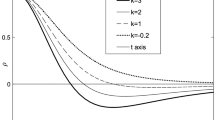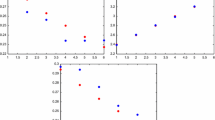Abstract
We give a characterization of positive definite integrable functions on a product of two Gelfand pairs as an integral of positive definite functions on one of the Gelfand pairs with respect to the Plancherel measure on the dual of the other Gelfand pair. In the very special case where the Gelfand pairs are Euclidean groups and the compact subgroups are reduced to the identity, the characterization is a much cited result in spatio-temporal statistics due to Cressie, Huang and Gneiting. When one of the Gelfand pairs is compact the characterization leads to results about expansions in spherical functions with positive definite expansion functions, thereby recovering recent results of the author in collaboration with Peron and Porcu. In the special case when the compact Gelfand pair consists of orthogonal groups, the characterization is important in geostatistics and covers a recent result of Porcu and White.
Similar content being viewed by others
References
Andrews, G.E., Askey, R., Roy, R.: Special Functions. Cambridge University Press, Cambridge (1999)
Apanasovich, T.V., Genton, M.G.: Cross-covariance functions for multivariate random fields based on latent dimensions. Biometrika 97, 15–30 (2010)
Berg, C.: Dirichlet forms on symmetric spaces. Ann. Inst. Fourier Grenoble 23(1), 135–156 (1973)
Berg, C., Forst, G.: Potential Theory on Locally Compact Abelian Groups. Springer, Berlin (1975)
Berg, C., Porcu, E.: From Schoenberg coefficients to Schoenberg functions. Constr. Approx. 45, 217–241 (2017)
Berg, C., Peron, A.P., Porcu, E.: Orthogonal expansions related to compact Gelfand pairs. Expo. Math. 36, 259–277 (2018)
Charalambides, C.A.: Enumerative Combinatorics. Chapman & Hall, Boca Raton (2002)
Cooper, J.L.B.: Positive definite functions of a real variable. Proc. Lond. Math. Soc. 10, 53–66 (1960)
Cressie, N., Huang, H.-C.: Classes of nonseparable, spatiotemporal stationary covariance functions. J. Am. Stat. Assoc. 94, 1330–1340 (1999)
Dai, F., Xu, Y.: Approximation Theory and Harmonic Analysis on Spheres and Balls. Springer, Berlin (2013)
Dawson, M., Ólafsson, G., Wolf, J.A.: Direct systems of spherical functions and representations. J. Lie Theory 23, 711–729 (2013)
Dieudonné, J.: Éléments D’Analyse, Tome VI. Chapitre XXII. Gauthier-Villars, Paris (1975)
Dixmier, J.: Les \(C^*\)-algèbres et Leurs Représentations. Gauthier-Villars, Paris (1964)
Faraut, J.: Analysis on Lie Groups. An Introduction. Cambridge University Press, Cambridge (2008)
Furrer, R., Porcu, E., Nychka, D.: A 30 years of space-time covariance functions. WIREs Comput. Stat. (2020). https://doi.org/10.1002/wics.1512
Gneiting, T.: Nonseparable, stationary covariance functions for space–time data. J. Am. Stat. Assoc. 97, 590–600 (2002)
Gneiting, T.: Strictly and non-strictly positive definite functions on spheres. Bernoulli 19(4), 1327–1349 (2013)
Kotz, S., Ostrovskii, I.V., Hayfavi, A.: Analytic and asymptotic properties of Linnik’s probability densities. I. J. Math. Anal. Appl. 193, 353–371 (1995)
Linnik, Ju.V.: Linear forms and statistical criteria, I, II. Select. Transl. Math. Stat. Probab. 3, 1–90 (1963). [Original paper appeared in Ukrainskii Mat. Zh. 5 (1953), 207–290.]
Mateu, J., Porcu, E.: Positive Definite Functions: From Schoenberg to Space–Time Challenges. University Jaume I, Castellon, Spain, Department of Mathematics (2008)
Phillips, T.R.L., Schmidt, K.M.: On unbounded positive definite functions. Math. Pannon. 26(2), 33–51 (2018)
Porcu, E., White, P.: Towards a complete picture of stationary covariance functions on spheres cross time. Electron. J. Stat. 13, 2566–2594 (2019)
Porcu, E., Cleanthous, G., Georgiadis, G., White, P.A., Alegria A.: Random fields on the hypertorus: Covariance modeling, regularities and approximations. Technical Report: Submitted for publication
Porcu, E., Gregori, P., Mateu, J.: Nonseparable stationary anisotropic space-time covariance functions. Stoch. Environ. Res. Risk Assess. 21, 113–122 (2006)
Rudin, W.: Fourier Analysis on Groups. Interscience, New York (1962)
Sasvári, Z.: Positive Definite and Definitizable Functions. Akademie, Berlin (1994)
Schoenberg, I.J.: Positive definite functions on spheres. Duke Math. J. 9, 96–108 (1942)
Stein, E.M., Weiss, G.: Introduction to Fourier Analysis on Euclidean Spaces. Princeton University Press, Princeton (1971)
van Dijk, G.: Introduction to Harmonic Analysis and Generalized Gelfand Pairs De Gruyter Studies in Mathematics, 36. Walter de Gruyter & Co, Berlin (2009)
Widder, D.V.: The Laplace Transform. Princeton University Press, Princeton (1941)
Wolf, J.A.: Harmonic Analysis on Commutative Spaces. Mathematical Surveys and Monographs, vol. 142. American Mathematical Society, New York (2007)
Acknowledgements
The author wants to thank Emilio Porcu, Zoltán Sasvári and Ryszard Szwarc for valuable advice during the preparation of this paper. The author also wants to thank two independent referees for valuable comments.
Author information
Authors and Affiliations
Corresponding author
Additional information
Communicated by Marcin Bownik.
Publisher's Note
Springer Nature remains neutral with regard to jurisdictional claims in published maps and institutional affiliations.
Appendix
Appendix
We shall give an example showing that the functions \(C({\mathbf {h}};u)\) constructed in Proposition 1.1 need not be integrable.
In the following \({\mathcal { F}} f\) denotes the Fourier transform of a function \(f:{\mathbb {R}}\rightarrow {\mathbb {C}}\) given by
Let \(C_0(]-1,1[)\) denote the set of continuous functions \(f:]-1,1[\rightarrow {\mathbb {C}}\) vanishing at “infinity”, i.e.,
It is a Banach space under the uniform norm
We proceed in a number of steps.
1: There exists \(f\in C_0(]-1,1[)\) such that \({\mathcal { F}} f\notin L^1({\mathbb {R}})\).
This is a classical application of the Banach-Steinhaus Theorem to the continuous linear functionals on the Banach space \(C_0(]-1,1[)\):
In fact, assuming that \(L_n, n\ge 0\) is pointwise bounded, we get that \(||L_n||\) is bounded, which is a contradiction because
tends to infinity for \(n\rightarrow \infty \). This shows the existence of an \(f\in C_0(]-1,1[)\) such that \((L_n(f))\) is an unbounded sequence, and in particular \({\mathcal { F}} f\notin L^1({\mathbb {R}})\).
2: There exists \(f\in C_0^+(]-1,1[)\) with \(\max f=1\) such that \({\mathcal { F}} f\notin L^1({\mathbb {R}})\).
This is an easy consequence of 1.
3: There exists \(f\in C_c^+({\mathbb {R}})\) with \(\max f=1\) and \(f(x)>0\) for \(x\in [0,1]\) such that \({\mathcal { F}} f\notin L^1({\mathbb {R}})\).
For f as in 2 let \(x_0\in {\mathbb {R}}\) satisfy \(f(x_0)=1\). Then there exists \(\delta >0\) such that \(f(x)>0\) for \(x\in [x_0,x_0+\delta ]\), and \(x\mapsto f(\delta x+x_0)\) satisfies 3.
4: There exists \(f\in C({\mathbb {R}})\cap L^1({\mathbb {R}})\) such that \(0<f(x)<1\) for all \(x\in {\mathbb {R}}\) and \({\mathcal { F}} f\notin L^1({\mathbb {R}})\).
Let h have the properties of 3 and let \(a_n>0, n\in {\mathbb {Z}}\) be such that \(a_0=1/2\), \(\sum _{n\in {\mathbb {Z}},n\ne 0} a_n=1/4\). Then
is continuous and has the properties \(0<f(x)\le 3/4\) for \(x\in {\mathbb {R}}\) and \(\int f(x)dx=3/4\int h(x)dx<\infty \). Furthermore,
hence
showing that \({\mathcal { F}} f\notin L^1({\mathbb {R}})\).
Conclusion Define
where f satisfies 4. Then g is strictly positive, continuous and integrable and
satisfies (C1’) and (C2’) of Proposition 1.1 with \(d=1\) and
Rights and permissions
About this article
Cite this article
Berg, C. A Unified View of Space–Time Covariance Functions Through Gelfand Pairs. J Fourier Anal Appl 26, 90 (2020). https://doi.org/10.1007/s00041-020-09793-z
Received:
Revised:
Published:
DOI: https://doi.org/10.1007/s00041-020-09793-z




